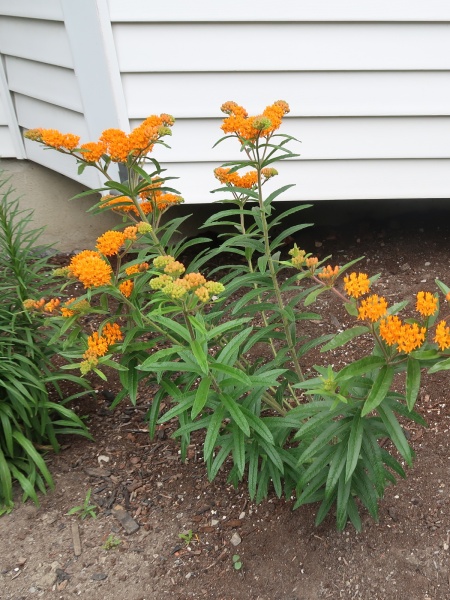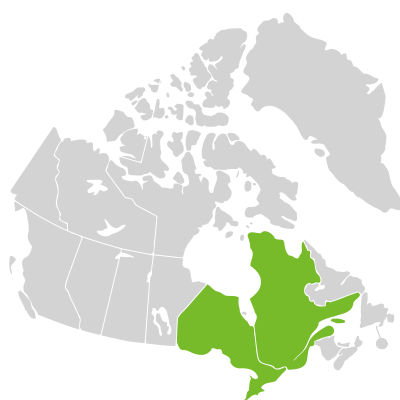 Known to be toxic - Toxic to mammals if ingested.
Known to be toxic - Toxic to mammals if ingested.

Source: OWSL
Asclepias tuberosa
Butterfly Milkweed
Asclépiade tubéreuse
Synonyms
butterflyweed
orange milkweed
pleurisy root
Seeds in stock
Available at table Mixed Sun, Dry
Available at table Mixed Sun, Dry
We currently accept seeds for this plant
Bloom Colour: Orange
Bloom Period: Jun - Aug
Max Height: 2.0 feet
Max Width: 3.0 feet
Light Condition:
 More than 6 hours of direct sun a day
More than 6 hours of direct sun a day
 More than 2 or 3 hours but less than 6 hours of direct sun a day
Soil conditions:
More than 2 or 3 hours but less than 6 hours of direct sun a day
Soil conditions:
 Tolerates dry soil condition
Tolerates dry soil condition
 Tolerates medium soil condition
Tolerates medium soil condition
 More than 6 hours of direct sun a day
More than 6 hours of direct sun a day
 More than 2 or 3 hours but less than 6 hours of direct sun a day
More than 2 or 3 hours but less than 6 hours of direct sun a day
 Tolerates dry soil condition
Tolerates dry soil condition
 Tolerates medium soil condition
Tolerates medium soil condition
Lifespan:
Perennial
plants that will that come back year after year
Gardener Experience:
 Suitable for beginner gardeners
Suitable for beginner gardeners
 Does not spread uncontrollably
Does not spread uncontrollably
 Self-seeding
Self-seeding
 Suitable for beginner gardeners
Suitable for beginner gardeners
 Does not spread uncontrollably
Does not spread uncontrollably
 Self-seeding
Self-seeding
Landscape Uses:
 Suitable for rock gardens
Suitable for rock gardens
 Suitable for Right of Way gardens
Suitable for Right of Way gardens
 Suitable for rain gardens
Suitable for rain gardens
 Suitable for container garden
Suitable for container garden
 Suitable for school gardens
Suitable for school gardens
 Tolerates boulevard garden conditions
Tolerates boulevard garden conditions
 Suitable for rock gardens
Suitable for rock gardens
 Suitable for Right of Way gardens
Suitable for Right of Way gardens
 Suitable for rain gardens
Suitable for rain gardens
 Suitable for container garden
Suitable for container garden
 Suitable for school gardens
Suitable for school gardens
 Tolerates boulevard garden conditions
Tolerates boulevard garden conditions
Ecological Benefits:
 Supports hummingbirds
Supports hummingbirds
 Supports pollinators
Supports pollinators
 Butterfly host
Butterfly host
 Supports hummingbirds
Supports hummingbirds
 Supports pollinators
Supports pollinators
 Butterfly host
Butterfly host
Tolerates:
 Tolerates drought conditions
Tolerates drought conditions
 Tolerates salt conditions
Tolerates salt conditions
 Tolerates limestone conditions
Tolerates limestone conditions
 Tolerates sandy conditions
Tolerates sandy conditions
 Tolerates juglone conditions
Tolerates juglone conditions
 Tolerates drought conditions
Tolerates drought conditions
 Tolerates salt conditions
Tolerates salt conditions
 Tolerates limestone conditions
Tolerates limestone conditions
 Tolerates sandy conditions
Tolerates sandy conditions
 Tolerates juglone conditions
Tolerates juglone conditions
Special Features and Considerations:
Plant Location
Native to Ottawa region: Yes
Distribution according to VASCAN

Ephemeral
Native
Introduced
Excluded
Extirpated
Doubtful
Absent
Thrives in Ecozones
- Boreal Shield
- Mixed Wood Plains
Ecological Benefits
Butterflies Supported by Asclepias tuberosa
- Danaus plexippus (Monarch)
- Trichordestra legitima (Striped Garden Caterpillar)
Specialized Bees Supported by Asclepias tuberosa
No bee data available for this plant.
Plants that grow in similar conditions, that bloom at the same time.
Complementary Plants
- Anaphalis margaritacea
Pearly Everlasting
Immortelle blanche - Liatris spicata
Dense Blazing Star
Liatris à épi - Monarda fistulosa
Wild Bergamot
Monarde fistuleuse - Rudbeckia hirta
Black-eyed Susan
Rudbeckie hérissée - Schizachyrium scoparium
Little Bluestem Grass
Barbon à balais
Substitute For Non-Native Plants
- Buddleia (Butterfly Bush)
- Asclepias (Milkweed Cultivars)
- Asclepias curassavica (Tropical Milkweed)
- Butomus umbellatus (Flowering Rush)
Sowing Information
Download Seed Envelope Labels (PDF)
- Sowing depth: Sow just below surface
- Sow by March
- Stratification duration: 30 days
- Self-seeding
Harvesting and Seed Sharing
- Harvest start month: September
- Harvesting indicator:
- Pods are slightly open and seeds inside are dark
- Harvesting:
- Use hand to detach from main stem
- Seed viability test:
- No test needed before donating
- Packaging measure: 1 rounded 1/8 teaspoon
- Seed storage:
- Air dry in paper bag or open container, for a few days until crisp
- Shake seeds to move them once in a while to prevent molding
- Cultivar: Yes, do not donate unless you know source, and there are no known cultivars in your garden or at proximity
- Remove non-seed material
- Harvesting video: Watch here
Toxicity Notes
Toxic to mammals if ingested.


 Canadensis
Canadensis
